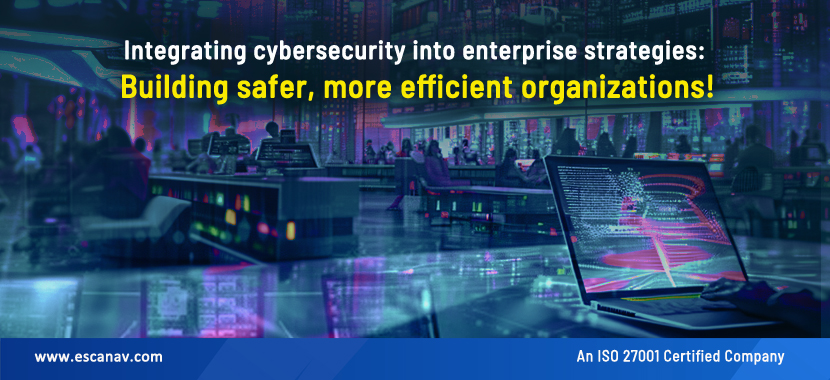In today’s digital world, where data drives decisions and innovation powers progress, cybersecurity is no longer just an IT concern—it’s a core component of business strategy. The growing prevalence of cyber threats, from ransomware to data breaches, has underscored the need for organizations to safeguard their digital assets. Integrating cybersecurity into enterprise strategies is not just about protecting sensitive information; it’s about building a resilient, efficient, and forward-thinking organization.
Here’s how businesses can integrate cybersecurity into their broader strategies to ensure safety and operational efficiency.
- Align Cybersecurity with Business Goals
The first step in integrating cybersecurity is aligning it with the overall business objectives. Every organization has unique goals—whether it’s market expansion, customer acquisition, or improving operational efficiency. Cybersecurity initiatives must be designed to support these goals. For example, if customer trust and data security are key to your growth strategy, implementing robust security protocols can enhance your brand reputation and foster trust.
Cybersecurity should be viewed as an enabler of growth, not a roadblock. It supports digital transformation efforts by ensuring that new technologies and processes are secure, minimizing the risk of disruptions that could impact productivity and profitability.
- Embed Cybersecurity into Organizational Culture
Effective cybersecurity starts with people. While advanced tools and technologies are essential, a security-aware culture is equally important. Employees are often the first line of defence against cyber threats, making security training and awareness programs a crucial component of any strategy. By fostering a security culture, organizations can minimize human error and reduce vulnerabilities.
Leadership should prioritize cybersecurity by embedding it into everyday operations. Encourage employees to follow best practices, such as regularly updating passwords, recognizing phishing attempts, and reporting suspicious activities.
- Leverage Advanced Technologies for Proactive Defense
Integrating cybersecurity into enterprise strategies means leveraging advanced technologies that offer proactive protection. Solutions like eScan’s Enterprise EDR (Endpoint Detection and Response) and DLP (Data Loss Prevention) systems allow businesses to detect threats before they cause significant damage. These tools enable real-time monitoring, anomaly detection, and swift incident response, providing enterprises with the agility to counter cyberattacks effectively.
Investing in threat intelligence and automated cybersecurity solutions can enhance an organization’s ability to foresee, prevent, and respond to attacks, ultimately ensuring a smoother and safer operational flow.
- Incorporate Cybersecurity into Digital Transformation
Digital transformation is essential for businesses to stay competitive but also opens new doors for cyber risks. Organizations adopting cloud services, IoT devices, and AI-driven systems must integrate cybersecurity at every step of this journey. Secure-by-design principles should be implemented across all digital initiatives, from software development to network infrastructure upgrades.
By including cybersecurity in the early stages of technology adoption, businesses can avoid vulnerabilities and secure their digital ecosystems, allowing innovation to flourish without compromising safety.
- Regulatory Compliance and Risk Management
Compliance with cybersecurity regulations is a critical part of enterprise strategy. Governments around the world are imposing stricter regulations to ensure that businesses protect sensitive data and maintain high-security standards. From GDPR to HIPAA, organizations must integrate compliance into their cybersecurity strategies to avoid fines and reputational damage.
Additionally, risk management plays a vital role in building resilience. Conducting regular risk assessments allows businesses to identify potential weaknesses in their infrastructure, enabling them to implement appropriate safeguards and ensure ongoing operational efficiency.
- Collaboration with Cybersecurity Experts
Many businesses, particularly SMEs, may not have in-house expertise to handle complex cybersecurity challenges. Partnering with external cybersecurity experts, like eScan, can bridge this gap. Our cybersecurity solutions are designed to meet the evolving needs of enterprises, offering comprehensive protection, tailored solutions, and expert guidance.
By collaborating with specialized providers, businesses can focus on their core operations, knowing that their digital environments are secured by the best in the field.
- Building Resilience through Incident Response Planning
Cybersecurity is not only about prevention but also about response. A well-designed incident response plan ensures that businesses can quickly recover from attacks with minimal disruption. Integrating incident response into business continuity plans is crucial for mitigating the effects of a breach and maintaining operational efficiency.
An enterprise-wide incident response strategy should include regular drills, clear roles and responsibilities, and a communication plan that keeps stakeholders informed during a cyber crisis.
Conclusion: Security as a Business Enabler
As the digital landscape continues to evolve, cybersecurity must be a top priority in every enterprise strategy. By integrating security measures into every aspect of your business—from culture and technology adoption to risk management and compliance—your organization can enhance its resilience, protect its assets, and foster growth.
At eScan, we understand the importance of building a secure foundation for modern enterprises. Our cutting-edge cybersecurity solutions provide the tools and expertise needed to protect your business, allowing you to focus on innovation and efficiency.
Start securing your future with eScan today—because a safer business is a smarter business.






